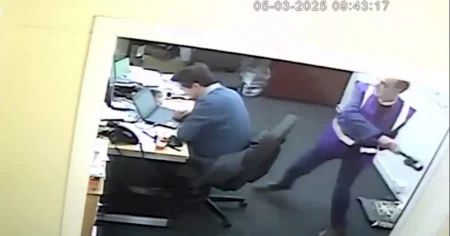The discovery of an unidentified deceased male in a Birmingham canal has prompted authorities to renew their efforts in determining his identity after more than a decade of unsuccessful attempts. The man’s body was recovered from the canal, sparking a protracted investigation that has, to date, yielded no definitive leads. In a renewed appeal to the public, investigators have released an e-fit image, a computer-generated likeness based on forensic analysis and available evidence, in the hopes that someone will recognize the man and provide information that can finally bring closure to this enduring mystery. The passage of time underscores the profound impact of this unsolved case, not only on the investigation but also on the potential family and friends of the deceased who remain unaware of his fate. The renewed appeal highlights the ongoing commitment of law enforcement to identify the unknown man and provide answers to the lingering questions surrounding his death.
The prolonged period of anonymity surrounding the deceased underscores the complexities of unidentified remains cases. Despite advances in forensic science and investigative techniques, identifying individuals whose bodies are discovered in circumstances like these can be incredibly challenging. Factors such as decomposition, lack of identifying documents, or the absence of witnesses can hinder the identification process. The release of the e-fit image signifies a renewed effort to overcome these challenges, leveraging technology and public awareness to generate leads and ultimately identify the man. The public’s participation is crucial in such cases, as a single piece of information, no matter how seemingly insignificant, can provide the breakthrough investigators need to solve the puzzle of the unknown man’s identity.
The circumstances surrounding the man’s death remain a focal point of the ongoing investigation. While the exact cause of death may not have been publicly disclosed, it is likely that investigators are exploring all possibilities, including accident, foul play, or natural causes. Determining the manner of death is critical not only for identifying the man but also for potentially uncovering any criminal activity that may be associated with the case. The passage of time complicates this aspect of the investigation, as potential evidence may have deteriorated or been lost. Nevertheless, the renewed appeal emphasizes the unwavering commitment of law enforcement to uncover the truth surrounding the man’s death and bring closure to this long-standing mystery.
The impact of this unresolved case extends beyond the immediate investigation and resonates within the broader community. The unknown man’s story represents a poignant reminder of the human cost of unidentified remains cases. Somewhere, there may be family and friends who are unaware of his fate, living with the unanswered questions and the pain of not knowing what happened to their loved one. The release of the e-fit image offers a glimmer of hope that someone, somewhere, will recognize the face and provide the crucial information needed to connect the deceased with his past and bring solace to those who may be searching for him.
The use of an e-fit image in this case highlights the increasing role of technology in forensic investigations. E-fit technology allows investigators to create a visual representation of the deceased based on forensic evidence and, if available, witness descriptions. This technology can be invaluable in cases where traditional identification methods have been unsuccessful. By disseminating the e-fit image widely, investigators are hoping to reach a broader audience and increase the chances of someone recognizing the man. The success of this approach depends on public engagement and the willingness of individuals to come forward with any information they may have, regardless of how insignificant it may seem.
The ongoing appeal to identify the man found in the Birmingham canal represents a testament to the perseverance of law enforcement and their commitment to solving cold cases. Despite the passage of time and the inherent challenges of identifying unknown remains, investigators remain dedicated to uncovering the truth and bringing closure to this enduring mystery. The release of the e-fit image, coupled with the renewed public appeal, signifies a renewed hope that someone will recognize the man and provide the crucial piece of information needed to finally identify him and bring peace to those who may be searching for answers. The success of this endeavor depends on the collective effort of law enforcement, the media, and the public, working together to solve this puzzle and bring a sense of closure to a tragic and long-unresolved case.














